
The common toad, European toad, or in Anglophone parts of Europe, simply the toad, is a frog found throughout most of Europe, in the western part of North Asia, and in a small portion of Northwest Africa. It is one of a group of closely related animals that are descended from a common ancestral line of toads and which form a species complex. The toad is an inconspicuous animal as it usually lies hidden during the day. It becomes active at dusk and spends the night hunting for the invertebrates on which it feeds. It moves with a slow, ungainly walk or short jumps, and has greyish-brown skin covered with wart-like lumps.

The black toad, also known as the Inyo toad or Deep Springs toad, is a true toad that lives only in scattered oases in the Deep Springs Valley of Inyo County, California. In fact, its original scientific name, Bufo exsul, means "exiled toad", which refers to its species' isolation in a tiny spot in the high desert wilderness of the Californian Great Basin.

The southern toad is a true toad native to the southeastern United States, from eastern Louisiana and southeastern Virginia south to Florida. It often lives in areas with sandy soils. It is nocturnal and spends the day in a burrow. Its coloring is usually brown but can be red, gray, or black. It is approximately 8 cm (3 inches) long.
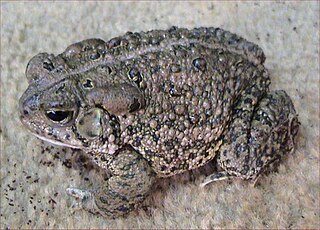
Woodhouse's toad is a medium-sized true toad native to the United States and Mexico. There are three recognized subspecies. A. woodhousii tends to hybridize with Anaxyrus americanus where their ranges overlap.
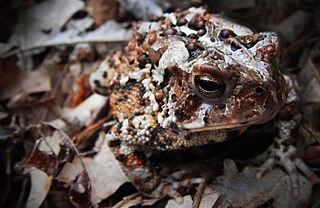
Fowler's toad is a species of toad in the family Bufonidae. The species is native to North America, where it occurs in much of the eastern United States and parts of adjacent Canada. It was previously considered a subspecies of Woodhouse's toad.
The Ailao toad is a species of toad in the family Bufonidae. It is endemic to China. Its natural habitats are subtropical or tropical moist montane forests and rivers. It was discovered in the Ailaoshan National Nature Reserve in Ailao Mountains, Yunnan. The toad was first described in 1984 and has not been seen since, as it is hard to find and thought to be rare. It is a small toad, about 40 mm (1.6 in) in length.

Bufo bankorensis is a species of toad in the family Bufonidae. It is endemic to Taiwan and widely distributed at elevations up to 3,000 m (9,800 ft) above sea level. There has been doubts about its separatedness from Bufo gargarizans from China and even other species, but it is currently considered a valid species.

Duttaphrynus kotagamai is a species of toad in the family Bufonidae endemic to Sri Lanka. Its natural habitats are tropical moist lowland forests, moist montane forests, and rivers. It is threatened by habitat loss. D. kotagamaii is named after Sarath Kotagama. A grown male is 33–40 mm in length, while a female reaches 55–63 mm. It is nocturnal, and lives commonly under rocks or decomposed leaves. It is found in Massena, Kitulgala, and Singharaja forests. Its diet consists of termites and grasshoppers. Its breeding biology has not been recorded, but it presumably takes place in water, probably in streams.
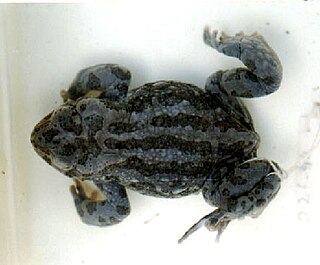
Bufotes latastii, commonly known as the Baltistan toad, Ladakh toad or vertebral-banded toad, is a species of toad in the family Bufonidae. It is found in the West Himalayan region at altitudes of 780–3,200 m (2,560–10,500 ft) from northern Pakistan to Ladakh in India; although sometimes reported elsewhere, this is the result of misidentifications of other species. It is found in alpine forests, coniferous forests, grasslands, paddy fields, mountain desert and roadsides. It often lives near water, like lakes and ponds, in the riparian growth. It can be beneficial to humans as it feeds on insects and their larvae within areas of agriculture.
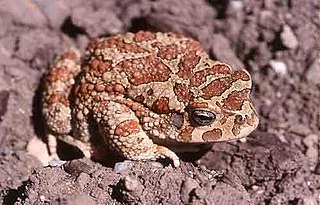
The Berber toad, also known as Mauritanian toad, Moroccan toad, pantherine toad or Moorish toad, is a species of toad in the family Bufonidae, which is found in north-western Africa, with an introduced population in southern Spain.

The pine toad is a species of toad in the family Bufonidae. It is endemic to Mexico and found on the Central Mexican Plateau.

Bufotes pewzowi is a species of toad in the family Bufonidae. It is found in dry plains of Central Asia, the foothills and mountains of Tian Shan, Zhungar Alatau and Pamir Mountains, the mountains and deserts of Western China and Mongolia, and probably westward to northern Afghanistan and north to Lake Balkhash in Kazakhstan and northeast Altai Republic in Russia. The specific name pewzowi honours Mikhail Pevtsov, a Russian geographer, cartographer, and explorer. Common names include Xinjiang toad and Pewzow's toad; when subspecies B. p. strauchi is recognized, it can be referred to as northern Xinjiang toad, while the nominotypic B. p. pewzowi then becomes southern Xinjiang toad.
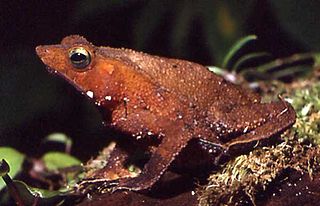
Rhinella proboscidea is a species of small South American toad in the family Bufonidae, common in the Amazon rainforest. It is the only species known to practice reproductive necrophilia.

The oak toad is a species of toad in the family Bufonidae. It is endemic to the coastal regions of southeastern United States. It is regarded as the smallest species of toad in North America, with a length of 19 to 33 mm.

The Japanese stream toad, also known as the Honshū toad, is a subspecies of toad in the family Bufonidae. It was first described by Masafumi Matsui in 1976 during research with Kyoto University as a "moderate to large-sized toad" with a "peculiar color pattern" and "stream-dwelling habits."

The Hyrcanian forests are a zone of lush lowland and montane forests covering about 55,000 square kilometres (21,000 sq mi) near the shores of the Caspian Sea in Iran and Azerbaijan. The forest is named after the ancient region of Hyrcania. The World Wide Fund for Nature refers to the ecoregion as the Caspian Hyrcanian mixed forests. Since 5 July 2019, the Hyrcanian Forests have been designated a UNESCO World Heritage Site. In September 2023, the heritage site expanded to incorporate portions of the forest located in Azerbaijan.

Ommatotriton ophryticus, the northern banded newt, is a species of newt in the family Salamandridae. It is found in northeastern Turkey and western Caucasus in Georgia, Armenia, and southern Russia.
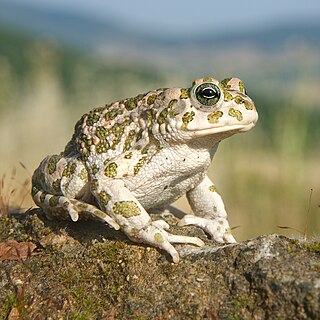
Bufotes, the Eurasian green toads or Palearctic green toads, is a genus of true toads. They are native to Europe, western and central Asia and northern Africa; a region roughly equalling the western and central Palearctic. Historically they were included in the genus Bufo and then for a few years placed in Pseudepidalea, which is a synonym of the currently accepted name Bufotes.



















